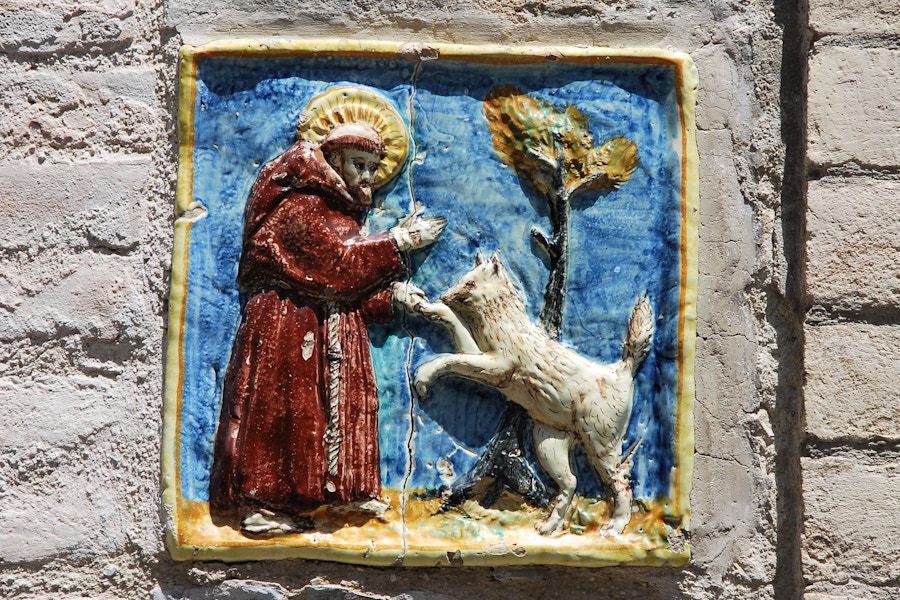Introductory Note:
As we near the end of a week celebrating St. Francis of Assisi, we look toward his model of a Spirit-filled life. The power of God worked through Francis’s life in innumerable ways, manifesting itself in miracles and astounding acts of charity. Richard Foster joins us again to relate some of the most memorable stories of Francis that exemplify life in the Charismatic tradition.
Read Richard’s introduction to “Francesco” here.
Renovaré Team
 Excerpt from Streams of Living Water
Excerpt from Streams of Living Water
But why would I think of Francis as a pivotal figure in the Charismatic Tradition?
Well, first of all, because of the striking power in the Spirit that surrounded all that Francis did and said. Perhaps one story will suffice. Clare — who by this time had established the “Second Order” of the Franciscans, “the poor Clares” — had often requested the opportunity to eat with Francis, but he had never granted her request. Finally some of the brothers urged him to consent, saying, “Father, it seems to us that this strictness is not according to divine charity … especially considering that she gave up the riches and pomp of the world as a result of your preaching.” In the end Francis was persuaded, and so a meeting was arranged at the little church of St. Mary of the Angels. Francis had a meal prepared and spread on the ground, as was his custom. Meeting at the appointed hour, “St. Francis and St. Clare sat down together, and one of his companions with St. Clare’s companion, and all his other companions were grouped around that humble table.” As they ate, Francis “began to speak about God in such a sweet and holy and profound and divine and marvelous way that he himself and St. Clare and her companion and all the others who were at that poor little table were rapt in God.”
In the meantime the people of Assisi were horrified to see in the distance St. Mary of the Angels and the entire forest around it enveloped in flames. They rushed up the hill, hoping to put out the blaze before everything was lost. But upon arriving at the little church, they found nothing amiss. No church on fire. No forest ablaze. Nothing. Entering the church they discovered Francis, Clare, and the others “sitting around that very humble table, rapt in God by contemplation and invested with power from on high.” They then realized that the fire they had seen was not a material fire, but a spiritual fire. The blaze they saw was “to symbolize the fire of divine love which was burning in the souls” of these simple servants of Christ. The end result of this astonishing event was that the people of Assisi returned home “with great consolation in their hearts and with holy edification.”
I know I said that one story would suffice, but how can I leave out the most famous Francis story of all: the taming of the ferocious wolf of Gubbio? It seems that a huge wolf had been terrorizing the citizens of Gubbio, killing several children. The people were so traumatized that they would hardly venture out of their homes, and certainly not beyond the town’s boundaries. Hearing this, Francis immediately determined to find the wolf. He struck out on the road to the area where it was often found, his companions following along at a safe distance. Seeing them coming, the wolf charged at them, open-mouthed and menacing. Francis firmly and gently called out to him, “Come to me, Brother Wolf. In the name of Christ, I order you not to hurt me or anyone.” His companions, at first frightened, were astonished to see the wolf stop in its tracks, close its jaws, lower its head, and lie down at Francis’s feet like a lamb. As it lay in front of him, Francis addressed the wolf: “Brother Wolf, you have done great harm in this region, … and this whole town is your enemy. But, Brother Wolf, I want to make peace between you and them, so that they will not be harmed by you any more.” He then proceeded to propose a peace pact between the wolf and the people of Gubbio: the wolf would promise not to terrorize and kill, and the people would promise to treat the wolf with courtesy and provide it with food. As the people watched in astonishment, “The wolf showed by moving its body and tail and ears and by nodding its head that it willingly accepted what the Saint had said and would observe it.” At this all the people “shouted to the sky, praising and blessing the Lord Jesus Christ.”
In this dramatic act the shalom of God descended upon that city, for we are told that “from that day, the wolf and the people kept the pact which St. Francis made. The wolf lived two years more, and it went from door to door for food. It hurt no one, and no one hurt it. The people fed it courteously. And it is a striking fact that not a single dog ever barked at it.”
Francis’s entire ministry was rich in miracles and healings, signs and wonders, revelations and visions. Once he encountered a blind girl from the city of Bevagna in the Spoleto Valley. Seeing her inward heart-devotion, he “marked the eyes of the blind girl with his spittle three times in the name of the Trinity and restored to her the sight she desired.” One man from the city of Orte had a tumor between his shoulders “the size of a large loaf of bread.” Francis, seeing his condition, laid hands on him and blessed him, and “he was suddenly so completely healed that no trace of the tumor remained.” The stories go on and on.


